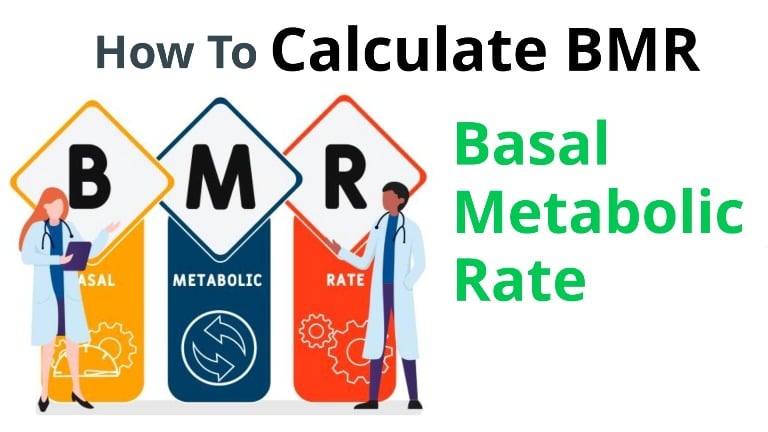
BMR Calculator
Your BMR: _____ Calories/day
Daily calorie needs based on your activity level:
| Activity Level | Calorie |
|---|---|
| Sedentary (little or no exercise) | |
| Light (Exercise 1-3 times/week) | |
| Moderate (Exercise 3-5 times/week) | |
| Very Active (Exercise 6-7 times/week) | |
| Extra Active (Extra heavy workouts) |
BMR (Basal Metabolic Rate) is the energy (measured in calories) the body needs to perform vital functions while at rest. In other words, it’s the energy your body needs to perform essential processes like breathing, circulating blood, regulating body temperature, and supporting the functions of vital organs such as the heart, brain, and kidneys.
The higher your BMR, the more calories you burn at rest. This means you can eat more calories daily and still lose weight.
Many factors can affect your BMR, including:
- Age: Your BMR decreases as you age.
- Sex: Men typically have higher BMRs than women.
- Body composition: People with more muscle mass have higher BMRs than people with more fat mass.
- Activity level: Your BMR increases when you are active.
- Genetics: Your genes partly determine your BMR.
Most people’s typical daily activity requirement (BMR) is about 60-70% of their total daily energy (calories). This includes the energy that the body expends to maintain the functions of our body, such as:
- Heartbeat
- Cell production
- Respiration
- Maintenance of body temperature
- Blood circulation
- Nutrient processing
Physical activity accounts for nearly 20% of expenditure, while digestion accounts for about 10%.
Your BMR can help you determine how many calories you must consume daily to maintain, lose, or gain weight.
- To lose weight, you need to create a calorie deficit. This means eating fewer calories than your BMR. You can do this by eating a healthy diet and exercising regularly.
- To gain weight, you need to create a calorie surplus. This means eating more calories than your BMR. You can do this by eating a calorie-dense diet and lifting weights.
OUR BMR calculator helps you do that quickly and accurately. Once you know your BMR, you can use it to make a calorie deficit or surplus to reach your weight goals.
Note: According to a 2005 meta-analysis study on BMR, despite controlling for all factors of metabolic rate, there remains an unknown variance of 26% among individuals. This means that even an average person on a regular diet may have expected BMR values, but there are still unknown factors that precisely determine BMR.
As a result, no BMR calculations, not even those done by experts using the most precise methods, will be completely accurate in their measurements.
BMR can be a starting point for your health or fitness goals but doesn’t provide much else.

How To Calculate BMR Using a Formula
The basic formula for calculating BMR (Basal Metabolic Rate):
The Harris-Benedict Equation was one of the earliest equations introduced. It was revised in 1984 to be more accurate and used until 1990 when the Mifflin-St. Jeor Equation was introduced.
Mifflin-St. Jeor Equation To Calculate BMR:
- For men: BMR = (10 x weight in kg) + (6.25 x height in cm) – (5 x age in years) + 5
- For women: BMR = (10 x weight in kg) + (6.25 x height in cm) – (5 x age in years) – 161
Calories Required As Per Activity Level
The number of calories a person needs daily depends on their level of physical activity. More active people typically require more calories to fuel their bodies.
- Sedentary (little or no exercise): BMR x 1.2
- Lightly active (1-3 days of exercise per week): BMR x 1.375
- Moderately active (3-5 days of exercise per week): BMR x 1.55
- Very active (6-7 days of exercise per week): BMR x 1.725
- Extra active (very intense exercise or physical job): BMR x 1.9
Exercises Level
- Exercise: 15–30 minutes of elevated heart rate activity.
- Intense exercise: 45–120 minutes of elevated heart rate activity.
- Very intense exercise: 2+ hours of elevated heart rate activity.
How To Use BMR To Lose Weight
To lose weight, you must consume fewer calories than you burn daily. To determine the calorie deficit required for weight loss, subtract 500–1000 calories from your BMR.
When you consume fewer calories than your BMR, you create a caloric deficit. This deficit forces your body to tap into its stored energy reserves, primarily fat, to meet its energy needs. A sustained caloric deficit leads to weight loss over time.
For example, if your BMR is 1500 calories per day, and you consume only 1200 calories daily, you create a 300-calorie deficit.
How To Use BMR To Gain Weight
You need to consume more calories than you burn daily to gain weight. Add 500–1000 calories to your BMR to determine the calorie surplus required.
This surplus provides the extra energy needed to support muscle growth and weight gain.
For example, if your BMR is 1800 calories per day and you consistently consume 2200 calories per day, you are creating a 400-calorie surplus.
The more significant the difference between your calorie intake and your BMR, the faster the rate of weight change. However, aiming for a sustainable deficit or surplus of 500–1000 calories is recommended for healthy, manageable weight loss or gain over time.
In addition to consuming a calorie surplus, strength training exercises can help build muscle mass and increase BMR.
References:
- Johnstone AM, Murison SD, Duncan JS, Rance KA, Speakman JR, Factors influencing variation in basal metabolic rate include fat-free mass, fat mass, age, and circulating thyroxine but not sex, circulating leptin, or triiodothyronine1. Am J Clin Nutr 2005; 82: 941-948.
- Schwarz, N. A., Rigby, B. R., La Bounty, P., Shelmadine, B., & Bowden, R. G. (2011). A Review of Weight Control Strategies and Their Effects on the Regulation of Hormonal Balance. Journal of Nutrition and Metabolism, 2011.
- Buchholz, A. C., Rafii, M., & Pencharz, P. B. (2001). Is resting metabolic rate different between men and women? British Journal of Nutrition, 86(6), 641–646.
- Lazzer, S., Bedogni, G., Lafortuna, C. L., Marazzi, N., Busti, C., Galli, R., De Col, A., Agosti, F., & Sartorio, A. (2010). Relationship between basal metabolic rate, gender, age, and body composition in 8,780 white obese subjects. Obesity (Silver Spring), 18(1), 71-8. doi:10.1038/oby.2009.162

Manish is a NASM-certified fitness and nutrition coach with over 10 years of experience in weight lifting and fat loss fitness coaching. He specializes in gym-based training and has a lot of knowledge about exercise, lifting technique, biomechanics, and more.
Through “Fit Life Regime,” he generously shares the insights he’s gained over a decade in the field. His goal is to equip others with the knowledge to start their own fitness journey.
